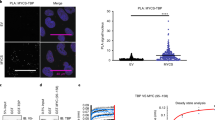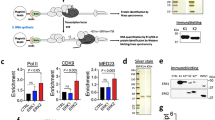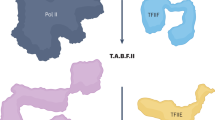Abstract
THE products of the cellular and retroviral fos genes associate with other nuclear proteins1,2, among them the transcription factor APl/Jun (see ref. 3 for a review). The Fos/Jun complex binds to a specific symmetrical DNA recognition sequence3–9 (termed TRE), thus stimulating transcription of the respective gene3,9–12. Here, we show that two distinct regions in Fos are required for the formation of a Fos/Jun/TRE complex. These are the leucine zipper13, involved in the association with Jun14, and a directly adjacent basic region. Specific amino-acid substitutions in this basic, presumably α-helical, region abolish the interaction of Fos/Jun with the TRE but not the association of the two proteins. The functionally crucial amino acids are located in a region of Fos which is structurally similar to the putative DNA-binding sites in Jun and in the yeast transcriptional activator GCN4 (refs 15 and 16).
This is a preview of subscription content, access via your institution
Access options
Subscribe to this journal
Receive 51 print issues and online access
$199.00 per year
only $3.90 per issue
Buy this article
- Purchase on Springer Link
- Instant access to full article PDF
Prices may be subject to local taxes which are calculated during checkout
Similar content being viewed by others
References
Curran, T., Van Beveren, C., Ling, N. & Verma, I. M. Molec. cell. Biol. 4, 167–172 (1985).
Franza, B. R. Jr, Sambucetti, L. C., Cohen, D. R. & Curran, T. Oncogene 1, 213–221 (1987).
Curran, T. & Franza, B. R. Jr Cell 55, 395–397 (1988).
Angel, P. et al. Cell 49, 729–739 (1987).
Lee, W. Mitchell, P. & Tjian, R. Cell 49, 741–752 (1987).
Distel, R. J., Ro, H.-S., Rosen, B. S., Groves, D. L. & Spiegelman, B. M. Cell 49, 835–844 (1987).
Rauscher III, F. J., Sambucetti, L. C., Curran, T., Distel, R. J. & Spiegelman, B. M. Cell 52, 471–480 (1988).
Rauscher III, F. J. et al. Science 240, 1010–1016 (1988).
Chiu, R. et al. Cell 54, 541–552 (1988).
Lucibello, F. C. et al. Oncogene 3, 43–51 (1988).
Schönthal, A., Herrlich, P., Rahmsdorf, H. J. & Ponta, H. Cell 54, 325–334 (1988).
Sassone-Corsi, P., Lamph, W. W., Kamps, M. & Verma, I. M. Cell 54, 553–560 (1988).
Landschulz, W. H., Johnson, P. F. & McKnight, S. L. Science 240, 1759–1764 (1988).
Schuermann, M. et al. Cell 56, 507–516 (1989).
Vingron, M., Nordheim, A. & Muller, R. Onc. Res. 3, 1–7 (1988).
Vogt, P. K., Bos, T. J. & Doolittle, R. F. Proc. natn. Acad. Sci. U.S.A. 84, 3316–3319 (1987).
Mölders, H., Jenuwein, T., Adamkiewicz, J. & Müller, R. Oncogene 1, 377–385 (1987).
Jenuwein, T. & Müller, R. Cell 48, 647–657 (1987).
Nakabeppu, Y., Ryder, K. & Nathans, D. Cell 55, 907–915 (1988).
Halazonetis, T. D., Georgopoulos, K. Greenberg, M. E. Leder, P. Cell 55, 917–924 (1988).
Kouzarides, T. Ziff, E. Nature 336, 646–651 (1988).
Sassone-Corsi, P., Ransone, L. J., Lamph, W. W. & Verma, I. M. Nature 336, 692–695 (1988).
Gamier, J., Osguthorpe, D. J. & Robson, B. J. molec. Biol. 120, 97–120 (1978).
Chou, P. Y. & Fasman, G. D. Biochemistry 13, 222–245 (1974).
Van Beveren, C., Enami, S., Curran, T. & Verma, I. M. Virology 135, 229–234 (1984).
Ryseck, R.-P., Hirai, S. I., Yaniv, M. & Bravo, R. Nature 334, 535–539 (1988).
Barberis, A., Saperti-Furga, G. & Busslinger, M. Cell 50, 347–359 (1987).
Author information
Authors and Affiliations
Rights and permissions
About this article
Cite this article
Neuberg, M., Schuermann, M., Hunter, J. et al. Two functionally different regions in Fos are required for the sequence-specific DNA interaction of the Fos/Jun protein complex. Nature 338, 589–590 (1989). https://doi.org/10.1038/338589a0
Received:
Accepted:
Issue Date:
DOI: https://doi.org/10.1038/338589a0
Comments
By submitting a comment you agree to abide by our Terms and Community Guidelines. If you find something abusive or that does not comply with our terms or guidelines please flag it as inappropriate.



